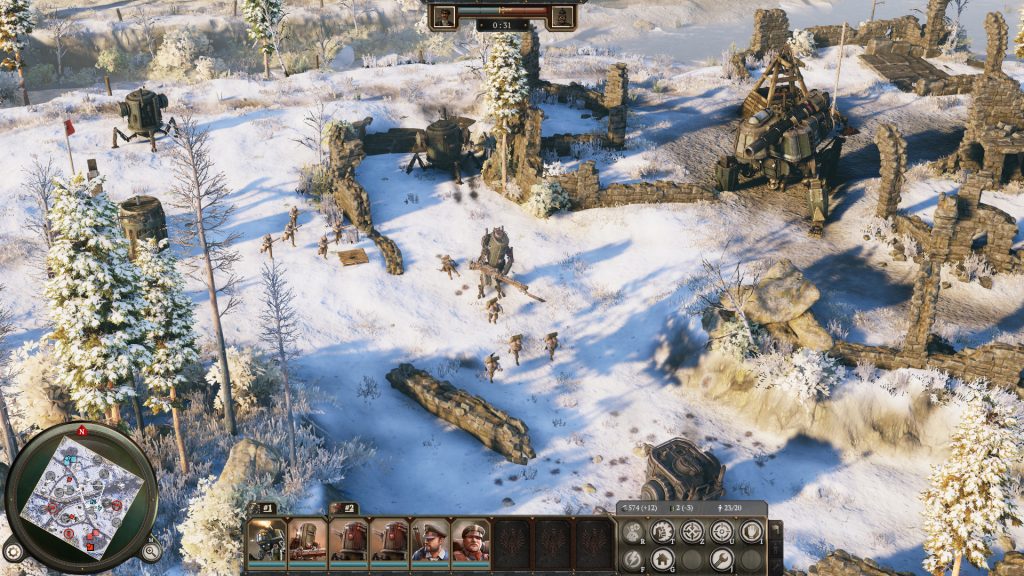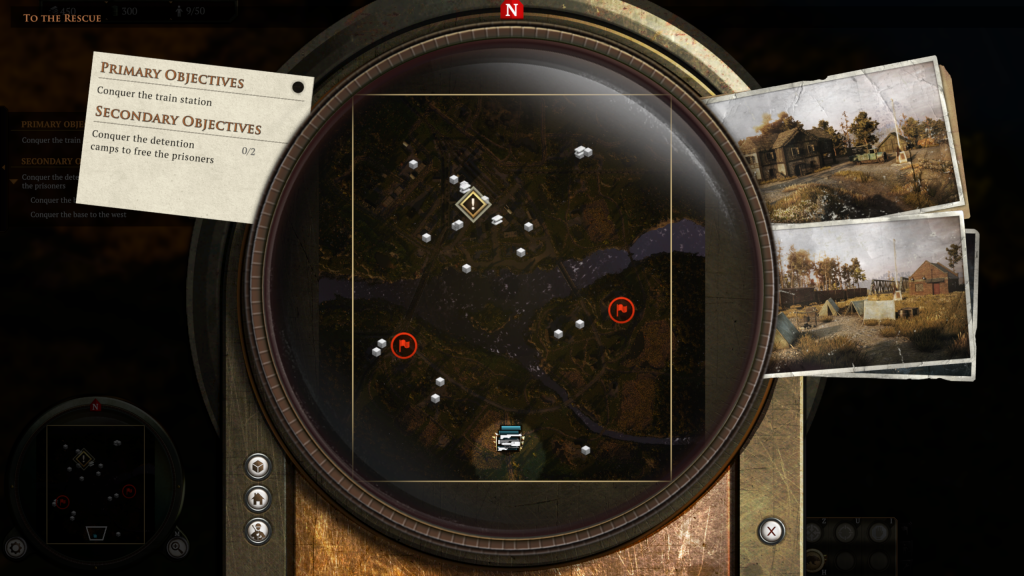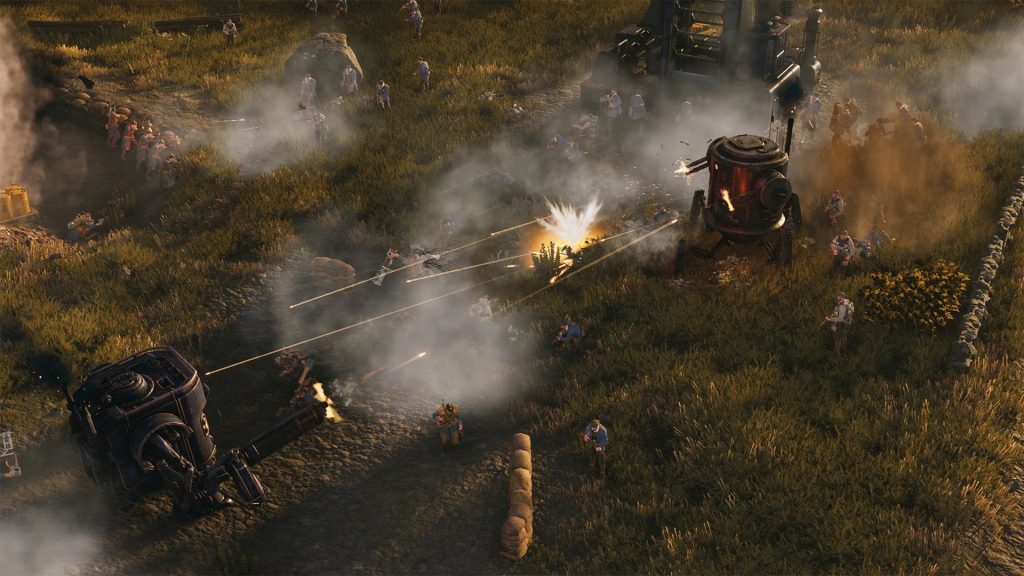It’s 1920 and The Great War has ended, but in this alternate reality tensions between the key nations of Europa are still high. Based upon Polish artist Jakub Różalski’ 1920+ universe, nations have dieselpunk like mechs at their disposal, as well as ground troops. Since the end of the war there has been what’s called an Iron Harvest, since the lands were littered with the remnants of war. There has already been a hugely popular strategy board game created using this unique setting, Scythe, but does it work in a video game? Let’s find out!
Booting up the game there is one place to start and that is the Polania campaign. With the start acting more like a tutorial, the early missions guide players loosely through some of the key features – as well as the basics that RTS veterans will speed through. It doesn’t shout out exactly how impactful things, like cover and being unseen, can be. Still, it does teach players how to do those things. They are intuitive to understand though, like crouching behind cover being a better defensive position than in the middle of an open field.
These early missions, and the campaigns as a whole, do a great job of filling out the lore of the alternate 1920s Europa. They take known characters, as they appear in the board game of Scythe, and allow fans to discover some of their backstory, or they just help show what is shaping the 1920+ world. The three campaigns move the player forward through a narrative rather than the story being there just to glue the missions together. Playing through them players get a sense of what has made each nation different, explaining not only the plot differences but why the nations specialties are what they are. You’ll even come to care for some of the characters, something which is a little unusual in an RTS game. It isn’t an Oscar winning script but as RTS plots go Iron Harvest has one that is well worthy of experiencing.

The lore helps craft the world but it is the stunning look of the gameworld that sells the locations and the animations that makes it believable. With a strong amount of zoom, players can see the realistic textures across the battlefields from muddy skirmish sites to arctic snowy ruins through to the plumes of smoke. The usage of destructible cover and environmental features go a long way towards making the explosions feel powerful and give weight to the bigger mechs. It also creates a very interesting angle to small skirmishes, with players needing to pick better cover or move before it becomes worthless. After grenades, cannon shots and more, what could have been an area enclosed with fences could be more like an open field, which is a lot riskier to fight in.
Unfortunately, not everything is perfect when it comes to the presentation – with small oddities snapping players out of the immersion. A few odd animations detract from what otherwise is amazing combat to watch. Occasionally, when a unit in cover fires a gun aiming in one direction the shot is fired in a completely different direction – sometimes even at a right angle. Interestingly, the correct and selected target will have been shot. Alas, seeing this immediately ejects the player from the immersive battle, which the rest of the visual appearance worked so hard to create. On top of this, more as an annoyance, the game doesn’t run too comfortably at 4K. Still, it looks great at 1440p, minus a couple of screen tearing elements when loading in.
Mechs pack a punch, though they aren’t unstoppable. Like any truly great RTS title Iron Harvest has looked to balance units in a variety of ways. From the cooldowns of various abilities to having units that directly counter others, mechs were not above this balance pass. They can decimate an unprepared unit, with plumes of fire, huge blasts and charges. Send one in alone though and a couple of units can bring one crashing down. It is all about defending those big hitting units at your disposal, even if it is just drawing some fire away from them so they can fulfill a purpose.

For the most part the AI are capable of putting up a fight and being a competent adversary, yet at times they seem more confused than commanding. A fight can be fairly even and suddenly the AI will prioritise a unit above all else. This will see units of troops forgo cover, or mechs charge into surrounded positions, in a last ditch attempt. This would be fine if the battle was close to being over but this hasn’t been the case, at least until after the kamikaze move. Enemy pathing has also been their demise on a couple of occasions, running the wrong side of a wall before jumping over it for cover, only for half of them to have not made it over the wall.
Units can have a range of abilities, making them more effective in specific situations. From using a main character’s ability, such as Anna Kos’ powerful sniper shot, to simple things such as throwing grenades, these all require the player to select the unit, click the power and then where or what to use it on. It may not sound like much but combine this with the time to perform the action and the skill can miss. The cover might have already been blown up, the mech may have moved or the unit already offed. It’s just a little frustrating then waiting for the cooldown of the ability, before trying again.
Iron Harvest may have now officially launched but there is still a lot of coming soon content – so the game feels like it is in Early Access. These aren’t just nice extras to add variety, such as the additional 3 new PvP maps planned for during September. Across the next few weeks the ability to play the campaign cooperatively, play in a ranked mode and even be able to autocast abilities is scheduled. It would have helped the game to have this content in from launch, but at least the developers are supporting the game.

In its current form Iron Harvest 1920+ offers a solid RTS experience, which brings an incredible alternate universe to life. It doesn’t break from the norm in terms of gameplay but it is the narrative and setting that sets the game apart from the rest. There are bugs that need fixing, from the AI to graphical glitches, which will improve the quality of the experience tenfold. The development team has been rather upfront revealing what new content will be released throughout September. It just feels like the game was rushed to mean the 1.9.20 release date, when releasing in a month’s time would have made for a more complete experience.
(Editor’s Note: Iron Harvest was provided to us by the publisher for the review. Check out the official Iron Harvest website here.)
